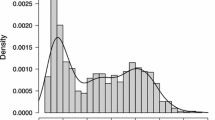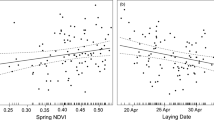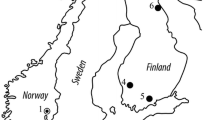Abstract
Animal territories that differ in the availability of food resources will require (all other things being equal) different levels of effort for successful reproduction. As a consequence, breeding performance may become most strongly dependent on factors that affect individual foraging where resources are poor. We investigated potential links between foraging behaviour, reproductive performance and morphology in a goshawk Accipiter gentilis population, which experienced markedly different resource levels in two different parts of the study area (rabbit-rich vs. rabbit-poor areas). Our analyses revealed (1) that rabbit abundance positively affected male reproductive output; (2) that age, size and rabbit abundance (during winter) positively affected different components of female reproductive output; (3) that foraging movements were inversely affected by rabbit abundance for both sexes (for females, this may mainly have reflected poor provisioning by males in the rabbit-poor area); (4) that younger breeders (both in males and females) tended to move over larger distances than older individuals (which may have reflected both a lack of hunting experience and mate searching); and (5) that male body size (wing length) showed some covariation with resource conditions (suggesting possible adaptations to hunting agile avian prey in the rabbit-poor area). Although we are unable to establish firm causal relationships with our observational data set, our results provide an example of how territory quality (here, food abundance) and individual features (here, age and morphology) may combine to shape a predator's foraging behaviour and, ultimately, its breeding performance.


Similar content being viewed by others
References
Arlettaz R, Krähenbühl M, Almasi B, Roulin A, Schaub M (2010) Wildflower areas within revitalized agricultural matrices boost small mammal populations but not breeding Barn Owls. J Ornithol 151:553–564
Bart J, Earnst SL (1999) Relative importance of male and territory quality in pairing success of male rock ptarmigan (Lagopus mutus). Behav Ecol Sociobiol 45:355–359
Bates DM, Sarkar D (2007) lme4: linear mixed-effects models using S4 classes, R package version 0.99875-6
Beier P, Drennan JE (1997) Forest structure and prey abundance in foraging areas of northern goshawks. Ecol Appl 7:564–571
Benson JF, Chamberlain MJ, Leopold BD (2006) Regulation of space use in a solitary felid: population density or prey availability? Anim Behav 71:685–693
Blondel J, Dias PC, Maistre M, Perret P (1993) Habitat heterogeneity and life-history variation of Mediterranean blue tits (Parus caeruleus). Auk 110:511–520
Börger L, Franconi N, Ferretti N, Meschi F, De Michele G, Gantz A, Coulson T (2006) An integrated approach to identify spatiotemporal and individual-level determinants of animal home range size. Am Nat 168:471–485
Burger J (1988) Effects of age on foraging in birds. In: Quellet H (ed) Proceedings of the Nineteenth International Ornithological Congress. University of Ottawa Press, Ottawa, pp 1127–1140
Burgess MD, Nicoll MAC, Jones CG, Norris K (2011) Multiple environmental gradients affect spatial variation in the productivity of a tropical bird population. J Anim Ecol 80:688–695
Burnham KP, Anderson DR (2002) Model selection and multi-model inference: a practical information-theoretic approach. Springer, New York
Campioni L, Delgado MM, Lourenço R, Bastianelli G, Fernández N, Penteriani V (2013) Individual and spatio-temporal variations in the home range behaviour of a long-lived, territorial species. Oecologia 172:371–385
Catchpole CK, Phillips JF (1992) Territory quality and reproductive success in the Dartford warbler Sylvia undata in Dorset, England. Biol Conserv 61:209–215
Charmantier A, Kruuk LEB, Blondel J, Lambrechts MM (2004) Testing for microevolution in body size in three blue tit populations. J Evol Biol 17:732–743
Ens BJ, Kersten M, Brenninkmeijer A, Hulscher JB (1992) Territory quality, parental effort and reproductive success of oystercatchers (Haematopus ostralegus). J Anim Ecol 61:703–715
Espie RHM, James PC, Oliphant LW, Warkentin IG, Liesk DJ (2004) Influence of nest-site and individual quality on breeding performance in merlins Falco columbarius. Ibis 146:623–631
Fernández N, Delibes M, Palomares F (2007) Habitat-related heterogeneity in breeding in a metapopulation of the Iberian lynx. Ecography 30:431–439
Grant BR, Grant PR (1989) Natural selection in a population of Darwin's finches. Am Nat 133:377–393
Green RH (1979) Sampling design and statistical methods for environmental biologists. Wiley, New York
Hakkarainen H, Huhta E, Lahti K, Lundvall P, Mappes T, Tolonen P, Wiehn J (1996) A test of male mating and hunting success in the kestrel: the advantages of smallness. Behav Ecol Sociobiol 39:375–380
Herfindal I, Linnell JDC, Odden J, Nilsen EB, Andersen R (2005) Prey density, environmental productivity and home-range size in the Eurasian lynx (Lynx lynx). J Zool 265:63–71
Hill GE (1988) Age, plumage brightness, territory quality and reproductive success in the black-headed grosbeak. Condor 90:379–388
Hoffmann AA, Parsons PA (1997) Consistent heritability changes under poor growth conditions. Trends Ecol Evol 12:460–461
Kenward RE (1982) Goshawk hunting behaviour, and range size as a function of food and habitat availability. J Anim Ecol 51:69–80
Kenward RE (2001) A manual for wildlife radio-tagging. Academic, London
Kenward RE (2006) The goshawk. T. & A.D. Poyser/A. & C, Black, London
Kenward RE, Marcström V, Karlbom M (1981) Goshawk winter ecology in Swedish pheasant habitats. J Wildl Manage 45:397–408
Kenward RE, Clarke RT, Hodder KH, Walls SS (2001) Density and linkage estimators of home range: nearest-neighbor clustering defines multi-nuclear cores. Ecology 82:1905–1920
Kenward RE, Marcström V, Karlbom M (1993a) Post-nestling behaviour in goshawk, Accipiter gentilis: I. The causes of dispersal. Anim Behav 46:365–370
Kenward RE, Marcström V, Karlbom M (1993b) Post-nestling behaviour in goshawk, Accipiter gentilis: II. Sex differences in sociality and nest-switching. Anim Behav 46:371–378
Kenward RE, Marcström V, Karlbom M (1999) Demographic estimates from radio-tagging: models of age-specific survival and breeding in the goshawk. J Anim Ecol 68:1020–1033
Kingsolver JG, Hoekstra HE, Hoekstra JM, Berrigan D, Vignieri SN, Hill CE, Hoang A, Gibert P, Beerli P (2001) The strength of phenotypic selection in natural populations. Am Nat 157:245–261
Krüger O (2005) Age at first breeding and fitness in goshawk Accipiter gentilis. J Anim Ecol 74:266–273
Krüger O, Stefener U (2000) Populationsfluktuation und die Rolle der Reproduktion in einer Population des Habichts Accipiter gentilis. Populationsökologie von Greifvogel und Eulenarten 4:263–271
Krüger O, Lindström J (2001) Habitat heterogeneity affects population growth in goshawk Accipiter gentilis. J Anim Ecol 70:173–181
Laaksonen T, Hakkarainen H, Korpimäki E (2004) Lifetime reproduction of a forest-dwelling owl increases with age and area of forest. Proc R Soc B 271:S461–S464
Lõhmus A, Vali Ü (2004) The effects of habitat quality and female size on the productivity of the lesser spotted eagle Aquila pomarina in the light of the alternative prey hypothesis. J Avian Biol 35:455–464
Loveridge AJ, Valeix M, Davidson Z, Murindagomo F, Fritz H, Macdonald DW (2009) Changes in home range size of African lions in relation to pride size and prey biomass in a semi-arid savannah. Ecography 32:953–962
Marchetti K, Price T (1989) Differences in the foraging of juvenile and adult birds—the importance of developmental constraints. Biol Rev 64:51–70
Marcström V, Kenward RE (1981) Sexual and seasonal variation in condition and survival of Swedish goshawks (Accipiter gentilis). Ibis 123:311–327
Mitchell MS, Powell RA (2007) Optimal use of resources structures home ranges and spatial distribution of black bears. Anim Behav 74:219–230
Nager RG, Keller LF, Van Noordwijk AJ (1998) Understanding natural selection on traits that are influenced by environmental conditions. In: Mouseau TA, Sinervo B, Endler JA (eds) Adaptive genetic variation in the wild. Oxford University Press, New York, pp 95–115
Newton I (1979) Population ecology of raptors. Poyser, Berkhamsted
Newton I (1986) The sparrowhawk. Poyser, Calton
Newton I (1991) Habitat variation and population regulation in sparrowhawks. Ibis 133:S76–S88
Newton I, Marquiss M, Moss D (1981) Age and breeding in sparrowhawks. J Anim Ecol 50:839–853
Nielsen JT, Drachmann J (2003) Age-dependent reproductive performance in northern goshawks Accipiter gentilis. Ibis 145:1–8
Ostfeld RS, Lidicker WZ Jr, Heske EJ (1985) The relationship between habitat heterogeneity, space use, and demography in a population of California voles. Oikos 45:433–442
Pennycuick CJ (1975) Mechanics of flight. In: Farner DS, King JR (eds) Avian biology. Academic, New York, pp 1–75
Penteriani V, Balbontín J, Ferrer M (2003) Simultaneous effect of age and territory quality on fecundity in Bonelli's eagle Hieraaetus fasciatus. Ibis 145:E77–E82
Penteriani V, Delgado MM, Gallardo M, Ferrer M (2004) Spatial heterogeneity and structure of bird populations: a case example with the eagle owl. Popul Ecol 46:185–192
Penteriani V, Kuparinen A, Delgado MM, Palomares F, López-Bao JV, Fedriani JM, Calzada J, Moreno S, Villafuerte R, Campioni L, Lourenço R (2013) Responses of a top and a meso predator and their prey to moon phases. Oecologia. doi:10.1007/s00442-013-2651-6
R Development Core Team (2009) R: a language and environment for statistical computing. R Foundation for Statistical Computing, Vienna
Reynolds RT (1972) Sexual dimorphism in Accipiter hawks: a new hypothesis. Condor 74:191–197
Rice WR (1989) Analyzing tables of statistical tests. Evolution 43:223–225
Roese JH, Risenhoover KL, Folse LJ (1991) Habitat heterogeneity and foraging efficiency: an individual-based model. Ecol Modell 57:133–143
Rutz C (2006) Home range size, habitat use, activity patterns and hunting behaviour of urban-breeding northern goshawks Accipiter gentilis. Ardea 94:185–202
Rutz C (2008) The establishment of an urban bird population. J Anim Ecol 77:1008–1019
Rutz C (2012) Predator fitness increases with selectivity for odd prey. Curr Biol 22:820–824
Rutz C, Whittingham MJ, Newton I (2006a) Age-dependent diet choice in an avian top predator. Proc R Soc B 273:579–586
Rutz C, Bijlsma RG, Marquiss M, Kenward RE (2006b) Population limitation in the northern goshawk in Europe: a review with case studies. Stud Avian Biol 31:158–197
Saïd S, Gaillard JM, Widmer O, Débias F, Bourgoin G (2009) What shape intra-specific variation in home range size? A case study of female roe deer. Oikos 118:1299–1306
Schluter D, Smith JMN (1986) Natural selection on beak and body size in the song sparrow. Evolution 40:221–230
Sergio F, Blas J, Forero MG, Donázar JA, Hiraldo F (2007) Size-related advantages for reproduction in a slightly dimorphic raptor: opposite trends between the sexes. Ethology 113:1141–1150
Sergio F, Blas J, Baos R, Forero MG, Donázar JA, Hiraldo F (2009) Short- and long-term consequences of individual and territory quality in a long-lived bird. Oecologia 160:507–514
Siikamäki P (1995) Habitat quality and reproductive traits in the pied flycatcher—an experiment. Ecology 76:308–312
Sokal RR, Rohlf FJ (1981) Biometry. Freeman, New York
Storer RW (1966) Sexual size dimorphism and food habits in three North American accipiters. Auk 83:423–436
Tornberg R, Mönkkönen M, Pahkala M (1999) Changes in diet and morphology of Finnish goshawks from 1960s to 1990s. Oecologia 121:369–376
van Beest FM, Rivrud IM, Loe LE, Milner JM, Mysterud A (2011) What determines variation in home range sizes across spatiotemporal scales in a large browsing herbivore? J Anim Ecol 80:771–785
Winkler DW, Allen PE (1996) The seasonal decline in tree swallow clutch size: physiological constraint or strategic adjustment? Ecology 77:922–932
Wunderle JM (1991) Age-specific foraging proficiency in birds. Curr Ornithol 8:273–324
Yom-Tov Y, Yom-Tov S (2006) Decrease in body size of Danish goshawks during the twentieth century. J Ornithol 47:644–647
Acknowledgments
The studies for this paper depended very substantially on the efforts of V. Marcström and M. Karlbom, with help from many field assistants, and financial support from the Swedish Sportsmen's Association and NERC (UK). We thank M.M. Delgado, O. Krüger, M. Melletti, R. Tornberg and an anonymous referee for their constructive comments on the manuscript. The study complied with the current laws of Sweden. V.P. was funded by the Spanish Secretaría General de Universidades, Ministry of Education (Salvador de Madariaga Program), and C.R. held a UK BBSRC David Phillips Fellowship during the preparation of this manuscript (BB/G023913/1 and BB/G023913/2).
Author information
Authors and Affiliations
Corresponding author
Additional information
Communicated by: Alexandre Roulin
Electronic supplementary material
Below is the link to the electronic supplementary material.
ESM 1
(DOC 59 kb)
Rights and permissions
About this article
Cite this article
Penteriani, V., Rutz, C. & Kenward, R. Hunting behaviour and breeding performance of northern goshawks Accipiter gentilis, in relation to resource availability, sex, age and morphology. Naturwissenschaften 100, 935–942 (2013). https://doi.org/10.1007/s00114-013-1093-7
Received:
Revised:
Accepted:
Published:
Issue Date:
DOI: https://doi.org/10.1007/s00114-013-1093-7




